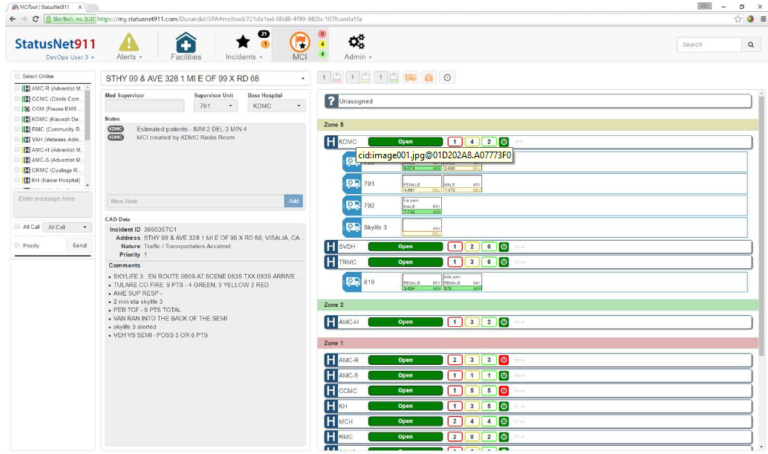Introduction
The Central California EMS Agency (CCEMSA) has been a StatusNet911 customer since 2003. The CCEMSA uses the application on a daily basis to communicate between hospitals and the EMS agency. The CCEMSA covers a 4 county area in Central California: Fresno County, Kings County, Madera County, and Tulare County. For detailed information, visit the CCEMSA. StatusNet911 is an integral part of their process and has its own page at CCEMSA StatusNet911 where they maintain a schedule of required education for all StatusNet911 users.
The application provides a single online deployment that integrates the data from two (2) EMS agencies computer aided dispatch (CAD) systems – Fresno County’s CAD and Tulare County’s CAD. There are a total of 19 facilities supported by the solution, comprised of fourteen (14) hospitals, two (2) county health departments, the CCEMSA, and two (2) dispatch centers that use StatusNet911 on a daily basis.
Impact to Operations: Insights from Daniel Lynch – EMS Director, CCEMSA
Before StatusNet911 was deployed in 2003, there was no consistency on how information was maintained regarding the hospital status or other system issues. Dispatchers would depend on making mental or paper notes of system resources, which would frequently be unreliable or the information outdated. Maintaining information for over fourteen (14) facilities, in this way, was also time consuming, and keeping information up-to-date was very difficult. Information was only a snap shot in time, which meant information was not always reliable. We needed the ability to see system information immediately in real-time. StatusNet911 gives us real-time information that is reliable and up-to-date.
Daniel Lynch, EMS Director,
Prior to StatusNet911 there was inconsistent management of multi-casualty incidents (MCI) and distribution of patients from large incidents, monitoring ambulance turnaround times was difficult, alerting hospitals and making hospitals
aware of the patients enroute was haphazard, and sharing hospital status and availability was almost impossible. All of this used to be accomplished through multiple telephone/radio calls, post-it notes, and multiple home-made forms.
StatusNet911 easily manages and monitors these functions and has a reporting capability to measure or monitor the system as needed.
StatusNet911 has improved the response, efficiency, and accuracy of information available to hospitals, dispatch centers and health departments. StatusNet911 has greatly improved our operating procedures by improving situational awareness throughout our four (4)county EMS region, improving the management of MCI responses, automating HAVBed compliance (saving hours of staff time), and providing more information to hospitals on incidents that are occurring in their communities.
Usage On a Daily or Non-Disaster Basis
Hospitals share status and resource availability including hospital diversion status, bed availability, medications, equipment, transport units, and triage status when MCIs occur, and whether they are equipped to handle contamination. In addition to the above statuses, StatusNet911 also calculates, in real-time, average drop times at each facility to provide dispatchers situational awareness regarding overburdened Emergency Departments (EDs), alternate EDs, and estimated return to service times. The dispatch centers share medical incidents as dispatched, the hospital assigned, and the incident response times as they are recorded in the CAD. Based on the online status displayed in the solution, at least 75% of the facilities are online through StatusNet911 at any given time.
A Hospital Available Beds for Emergencies and Disasters (HAvBED) report is automatically generated from data in the system. HAvBED is a federally-mandated program that requires states to collect and report local hospital available bed data. StatusNet911 supports EMS agencies requests for updated information from hospitals. The hospitals are alerted of a request and use the system to update the available beds online in StatusNet911. All communication and information requests in the StatusNet911 system are audited and reportable showing timeliness and compliance with response requests.
On occasion, EMS or the hospital will issue a Be On the Look Out (BOLO) for certain patients, persons of interest, or family members, A BOLO interface provides alerts through StatusNet911 and users at the 19 facilities see the alert across the system. BOLO functionality is one of the many features used to improve awareness and increase information for decision support.
The following image shows a sample of the real-time incident screen in StatusNet911.


Usage During Disasters, Terrorist Activity, and Other Mass Casualty Incidents
For Mass Casualty Incidents (MCI), disasters and terrorist activity, StatusNet911 provides the capability to manage an MCI from beginning to end. CCEMSA runs about 10 MCIs per month. MCIs supported recently, include automobile accidents, HAZMAT issues (e.g., overturned gasoline truck), and gang fights.
This region operates with a hospital based MCI Coordinator. An MCI is initiated by EMS field personnel when they find 5 or more patients on scene at an incident. Fresno County assigns an MCI Coordinator at a base hospital, then the MCI Coordinator upgrades the incident to an MCI on StatusNet911 opening access to the MCI tool and process flow. The MCI Coordinator then manages all patient assignment to vehicles, vehicle assignments to facilities and maintains updated information on triage status at each hospital.
The process uses a drag-and-drop interface, minimizing screens and clicks allowing rapid coordination in a single view of all patients, resources, transports, and facilities.


The solution includes multiple reports including an MCI Report that summarizes all the information & activities associated with an MCI.

